 W
WThe Battle of Albert comprised the first two weeks of Anglo-French offensive operations in the Battle of the Somme. The Allied preparatory artillery bombardment commenced on 24 June and the Anglo-French infantry attacked on 1 July, on the south bank from Foucaucourt to the Somme and from the Somme north to Gommecourt, 2 mi (3.2 km) beyond Serre. The French Sixth Army and the right wing of the British Fourth Army inflicted a considerable defeat on the German 2nd Army but from the Albert–Bapaume road to Gommecourt, the British attack was a disaster, where most of the c. 57,000 British casualties of the day were incurred. Against the wishes of General Joseph Joffre, General Sir Douglas Haig abandoned the offensive north of the road to reinforce the success in the south, where the Anglo-French forces pressed forward through several intermediate lines closer to the German second position.
 W
WThe Battle of Ali Masjid, which took place on 21 November 1878, was the opening battle in the Second Anglo-Afghan War between the British forces, under Lieutenant-General Sir Samuel James Browne, and the Afghan forces, under Ghulam Haider Khan. The perceived offence of an Afghan general's refusal to allow a British envoy entrance to the country was used as an excuse to attack the fortress of Ali Masjid, as the opening battle in the war. Despite numerous setbacks, including half the troops getting lost or delayed and missing the battle entirely, the British were lucky that the Afghans abandoned their position overnight.
 W
WThe Battle of the Argenta Gap was an engagement which formed part of the Allied spring 1945 offensive during the Italian Campaign in the final stages of the Second World War. It took place in northern Italy from 12–19 April 1945 between troops of British V Corps commanded by Lieutenant-General Charles Keightley and German units of LXXVI Panzer Corps commanded by Lieutenant General Gerhard von Schwerin.
 W
WThe Battle of Arras was a British offensive on the Western Front during World War I. From 9 April to 16 May 1917, British troops attacked German defences near the French city of Arras on the Western Front. The British achieved the longest advance since trench warfare had begun, surpassing the record set by the French Sixth Army on 1 July 1916. The British advance slowed in the next few days and the German defence recovered. The battle became a costly stalemate for both sides and by the end of the battle, the British Third and First Army had suffered about 160,000 casualties and the German 6th Army about 125,000.
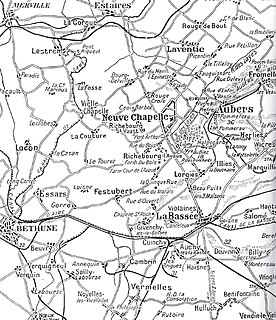 W
WThe Battle of Aubers was a British offensive on the Western Front on 9 May 1915 during the First World War. The battle was part of the British contribution to the Second Battle of Artois, a Franco-British offensive intended to exploit the German diversion of troops to the Eastern Front. The French Tenth Army was to attack the German 6th Army north of Arras and capture Vimy Ridge, preparatory to an advance on Cambrai and Douai. The British First Army, on the left (northern) flank of the Tenth Army, was to attack on the same day and widen the gap in the German defences expected to be made by the Tenth Army and to fix German troops north of La Bassée Canal.
 W
WThe Battle of Arras was a British offensive on the Western Front during World War I. From 9 April to 16 May 1917, British troops attacked German defences near the French city of Arras on the Western Front. The British achieved the longest advance since trench warfare had begun, surpassing the record set by the French Sixth Army on 1 July 1916. The British advance slowed in the next few days and the German defence recovered. The battle became a costly stalemate for both sides and by the end of the battle, the British Third and First Army had suffered about 160,000 casualties and the German 6th Army about 125,000.
 W
WThe Battle of Armentières was fought by German and Franco-British forces in northern France in October 1914, during reciprocal attempts by the armies to envelop the northern flank of their opponent, which has been called the Race to the Sea. Troops of the British Expeditionary Force (BEF) moved north from the Aisne front in early October and then joined in a general advance with French troops further south, pushing German cavalry and Jäger back towards Lille until 19 October. German infantry reinforcements of the 6th Army arrived in the area during October.
 W
WThe Second Battle of the Somme of 1918 was fought during the First World War on the Western Front from late August to early September, in the basin of the River Somme. It was part of a series of successful counter-offensives in response to the German Spring Offensive, after a pause for redeployment and supply.
 W
WThe Battle of the Lys, also known as the Fourth Battle of Ypres, was fought from 7 to 29 April 1918 and was part of the German Spring Offensive in Flanders during the First World War. It was originally planned by General Erich Ludendorff as Operation George but was reduced to Operation Georgette, with the objective of capturing Ypres, forcing the British forces back to the Channel ports and out of the war. In planning, execution and effects, Georgette was similar to Operation Michael, earlier in the Spring Offensive.
 W
WThe Battle of Canal du Nord was part of the Hundred Days Offensive of the First World War by the Allies against German positions on the Western Front. The battle took place in the Nord-Pas-de-Calais region of France, along an incomplete portion of the Canal du Nord and on the outskirts of Cambrai between 27 September and 1 October 1918. To prevent the Germans from sending reinforcements against one attack, the assault along the Canal du Nord was part of a sequence of Allied attacks at along the Western Front. The attack began the day after the Meuse-Argonne Offensive commenced, a day before an offensive in Belgian Flanders and two days before the Battle of St. Quentin Canal.
 W
WThe Drocourt-Quéant Line was a set of mutually supporting defensive lines constructed by Germany between the French towns of Drocourt and Quéant during World War I. This defensive system was part of the northernmost section of the Hindenburg Line, a vast German defensive system that ran through northeastern France.
 W
WThe Battle of Flers–Courcelette (15 to 22 September 1916) was fought during the Battle of the Somme in France, by the French Sixth Army and the British Fourth Army and Reserve Army, against the German 1st Army, during the First World War. The Anglo-French attack of 15 September began the third period of the Battle of the Somme but by its conclusion on 22 September, the strategic objective of a decisive victory had not been achieved. The infliction of many casualties on the German front divisions and the capture of the villages of Courcelette, Martinpuich and Flers had been a considerable tactical victory but the German defensive success on the British right flank, made exploitation and the use of cavalry impossible. Tanks were used in battle for the first time in history and the Canadian Corps and the New Zealand Division fought for the first time on the Somme. On 16 September, Jagdstaffel 2, a specialist fighter squadron, began operations with five new Albatros D.I fighters, which were capable of challenging British air supremacy for the first time since the beginning of the battle.
 W
WThe Battle of the Lys, also known as the Fourth Battle of Ypres, was fought from 7 to 29 April 1918 and was part of the German Spring Offensive in Flanders during the First World War. It was originally planned by General Erich Ludendorff as Operation George but was reduced to Operation Georgette, with the objective of capturing Ypres, forcing the British forces back to the Channel ports and out of the war. In planning, execution and effects, Georgette was similar to Operation Michael, earlier in the Spring Offensive.
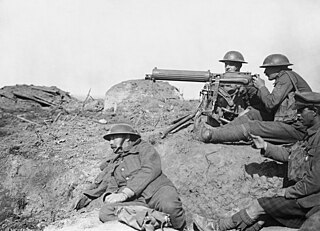 W
WThe Battle of the Menin Road Ridge, sometimes called "Battle of the Menin Road", was the third British general attack of the Third Battle of Ypres in the First World War. The battle took place from 20 to 25 September 1917, in the Ypres Salient in Belgium on the Western Front. During the pause in British and French general attacks from late August to 20 September, the British changed some infantry tactics, adopting the leap-frog method of advance.
 W
WThe Second Battle of the Somme of 1918 was fought during the First World War on the Western Front from late August to early September, in the basin of the River Somme. It was part of a series of successful counter-offensives in response to the German Spring Offensive, after a pause for redeployment and supply.
 W
WThe Battle of the Ancre (13–18 November 1916), was fought by the Fifth Army, against the German 1st Army. The battle was the final large British attack of the Battle of the Somme; the Reserve Army had been renamed on 30 October. After the Battle of Flers–Courcelette on 22 September, the Anglo-French armies tried to press their advantage with several smaller attacks in quick succession, rather than pause to regroup and give the Germans time to recover. Subsequent writers gave discrete dates for the Anglo-French battles but there were considerable overlaps and continuities of operations, until the weather and supply difficulties in mid-November ended the battle until the new-year.
 W
WThe Battle of St. Quentin Canal was a pivotal battle of World War I that began on 29 September 1918 and involved British, Australian and American forces operating as part of the British Fourth Army under the overall command of General Sir Henry Rawlinson. Further north, part of the British Third Army also supported the attack. South of the Fourth Army's 19 km (12 mi) front, the French First Army launched a coordinated attack on a 9.5 km (6 mi) front. The objective was to break through one of the most heavily defended stretches of the German Siegfriedstellung, which in this sector utilised the St Quentin Canal as part of its defences. The assault achieved its objectives, resulting in the first full breach of the Hindenburg Line, in the face of heavy German resistance. In concert with other attacks of the Grand Offensive along the length of the line, Allied success convinced the German high command that there was little hope of an ultimate German victory.
 W
WThe Battle of Bazentin Ridge (14–17 July 1916) was part of the Battle of the Somme (1 July – 18 November) on the Western Front in France, during the First World War. The British Fourth Army made a dawn attack on 14 July, against the German 2nd Army in the Brown Position from Delville Wood westwards to Bazentin le Petit Wood.
 W
WThe Battle of Broodseinde was fought on 4 October 1917 near Ypres in Belgium, at the east end of the Gheluvelt plateau, by the British Second and Fifth armies against the German 4th Army. The battle was the most successful Allied attack of the Third Battle of Ypres. Using bite-and-hold tactics, with objectives limited to what could be held against German counter-attacks, the British devastated the German defence, which prompted a crisis among the German commanders and caused a severe loss of morale in the 4th Army. Preparations were made by the Germans for local withdrawals and planning began for a greater withdrawal, which would entail the abandonment by the Germans of the Belgian coast, one of the strategic aims of the Flanders offensive.
 W
WThe Battle of Cambrai, 1918 was a battle between troops of the British First, Third and Fourth Armies and German Empire forces during the Hundred Days Offensive of the First World War. The battle took place in and around the French city of Cambrai, between 8 and 10 October 1918. The battle incorporated many of the newer tactics of 1918, in particular tanks. The attack was an overwhelming success with light casualties in an extremely short amount of time.
 W
WThe Battle of Cambrai was a British attack followed by the biggest German counter-attack against the British Expeditionary Force (BEF) since 1914, in the First World War. The town of Cambrai, in the département of Nord, was an important supply point for the German Siegfriedstellung and capture of the town and the nearby Bourlon Ridge would threaten the rear of the German line to the north. Major General Henry Tudor, Commander, Royal Artillery (CRA) of the 9th (Scottish) Division, advocated the use of new artillery-infantry techniques on his sector of the front. During preparations, J. F. C. Fuller, a staff officer with the Tank Corps, looked for places to use tanks for raids. General Julian Byng, commander of the British Third Army, decided to combine both plans. The French and British armies had used tanks in mass earlier in 1917, although to considerably less effect.
 W
WThe First Battle of El Alamein was a battle of the Western Desert Campaign of the Second World War, fought in Egypt between Axis forces of the Panzer Army Africa and Allied forces of the Eighth Army.
 W
WThe Siege of Ladysmith was a protracted engagement in the Second Boer War, taking place between 2 November 1899 and 28 February 1900 at Ladysmith, Natal, a township founded in 1850.
 W
WThe Battle of Delville Wood (15 July – 3 September 1916) was a series of engagements in the 1916 Battle of the Somme in the First World War, between the armies of the German Empire and the British Empire. Delville Wood (Bois d'Elville), was a thick tangle of trees, chiefly beech and hornbeam, with dense hazel thickets, intersected by grassy rides, to the east of Longueval. As part of a general offensive starting on 14 July, which became known as the Battle of Bazentin Ridge (14–17 July), General Douglas Haig, Commander of the British Expeditionary Force, intended to capture the German second position between Delville Wood and Bazentin le Petit.
 W
WThe First Battle of the Marne was a battle of the First World War fought from 6 to 12 September 1914. It resulted in an Allied victory against the German armies in the west. The battle was the culmination of the Retreat from Mons and pursuit of the Franco–British armies which followed the Battle of the Frontiers in August and reached the eastern outskirts of Paris.
 W
WThe Battle of Guillemont was an attack by the British Fourth Army on the village of Guillemont. The village is on the D 20 running east to Combles and the D 64 south-west to Montauban. Longueval and Delville Wood lie to the north-west and Ginchy to the north-east. The village was on the right flank of the British sector, near the boundary with the French Sixth Army. The Fourth Army had advanced close to Guillemont during the Battle of Bazentin Ridge (14–17 July) and the capture of the village was the culmination of British attacks which began on the night of 22/23 July. The attacks were intended to advance the right flank of the Fourth Army and eliminate a salient further north at Delville Wood. German defences ringed the wood and had observation over the French Sixth Army area to the south, towards the Somme river.
 W
WWhen the Second Boer War broke out on 11 October 1899, the Boers had a numeric superiority within Southern Africa. They quickly invaded the British territory and laid siege to Ladysmith, Kimberley and Mafeking. Britain meanwhile transported thousands of troops both from the United Kingdom itself and from elsewhere in the Empire and by the time the siege of Ladysmith had been lifted, had a huge numeric superiority.
 W
WThe Battle of Langemarck was the second Anglo-French general attack of the Third Battle of Ypres, during the First World War. The battle took place near Ypres in Belgian Flanders, on the Western Front against the German 4th Army. The French First Army had a big success on the northern flank from Bixschoote to Drie Grachten and the British gained a substantial amount of ground northwards from Langemark to the boundary with the French.
 W
WThe Battle of Le Cateau was fought on the Western Front during the First World War on 26 August 1914. The British Expeditionary Force (BEF) and the French Fifth Army had retreated after their defeats at the Battle of Charleroi and the Battle of Mons. The British II Corps fought a delaying action at Le Cateau to slow the German pursuit. Most of the BEF was able to continue its retreat to Saint-Quentin.
 W
WThe Battle of Le Transloy was the last big attack by the Fourth Army of the British Expeditionary Force (BEF) in the 1916 Battle of the Somme in France, during the First World War. The battle was fought in conjunction with attacks by the French Tenth and Sixth armies on the southern flank and the Reserve/5th Army on the northern flank, against Army Group Rupprecht of Bavaria created on 28 August. General Ferdinand Foch, commander of groupe des armées du nord and co-ordinator of the armies on the Somme, was unable to continue the sequential attacks of September because persistent rain, mist and fog grounded aircraft, turned the battlefield into a swamp and greatly increased the difficulty of transporting supplies to the front over the roads land devastated since 1 July.
 W
WThe Battle of the Lys, also known as the Fourth Battle of Ypres, was fought from 7 to 29 April 1918 and was part of the German Spring Offensive in Flanders during the First World War. It was originally planned by General Erich Ludendorff as Operation George but was reduced to Operation Georgette, with the objective of capturing Ypres, forcing the British forces back to the Channel ports and out of the war. In planning, execution and effects, Georgette was similar to Operation Michael, earlier in the Spring Offensive.
 W
WThe Macedonian front, also known as the Salonica front, was a military theatre of World War I formed as a result of an attempt by the Allied Powers to aid Serbia, in the fall of 1915, against the combined attack of Germany, Austria-Hungary and Bulgaria. The expedition came too late and in insufficient force to prevent the fall of Serbia, and was complicated by the internal political crisis in Greece. Eventually, a stable front was established, running from the Albanian Adriatic coast to the Struma River, pitting a multinational Allied force against the Bulgarian Army, which was at various times bolstered with smaller units from the other Central Powers. The Macedonian front remained quite stable, despite local actions, until the great Allied offensive in September 1918, which resulted in the capitulation of Bulgaria and the liberation of Serbia.
 W
WThe Battle of Messines was an attack by the British Second Army, on the Western Front near the village of Messines in West Flanders, Belgium, during the First World War. The Nivelle Offensive in April and May had failed to achieve its more grandiose aims, had led to the demoralisation of French troops and confounded the Anglo-French strategy for 1917. The attack forced the Germans to move reserves to Flanders from the Arras and Aisne fronts, relieving pressure on the French.
 W
WThe Battle of Morval, 25–28 September 1916, was an attack during the Battle of the Somme by the British Fourth Army on the villages of Morval, Gueudecourt and Lesbœufs held by the German 1st Army, which had been the final objectives of the Battle of Flers–Courcelette. The main British attack was postponed to combine with attacks by the French Sixth Army on the village of Combles south of Morval.
 W
WThe Battle of Neuve Chapelle took place in the First World War in the Artois region of France. The attack was intended to cause a rupture in the German lines, which would then be exploited with a rush to the Aubers Ridge and possibly Lille. A French assault at Vimy Ridge on the Artois plateau was also planned to threaten the road, rail and canal junctions at La Bassée from the south as the British attacked from the north. The British attackers broke through German defences in a salient at the village Neuve-Chapelle but the success could not be exploited.
 W
WThe Third Battle of Ypres, also known as the Battle of Passchendaele, was a campaign of the First World War, fought by the Allies against the German Empire. The battle took place on the Western Front, from July to November 1917, for control of the ridges south and east of the Belgian city of Ypres in West Flanders, as part of a strategy decided by the Allies at conferences in November 1916 and May 1917. Passchendaele lies on the last ridge east of Ypres, 5 mi (8.0 km) from Roulers junction of the Bruges (Brugge) to Kortrijk railway. The station at Roulers was on the main supply route of the German 4th Army. Once Passchendaele Ridge had been captured, the Allied advance was to continue to a line from Thourout to Couckelaere (Koekelare).
 W
WThe Battle of Pilckem Ridge was the opening attack of the Third Battle of Ypres in the First World War. The British Fifth Army, supported by the Second Army on the southern flank and the French 1reArmée on the northern flank, attacked the German 4th Army, which defended the Western Front from Lille northwards to the Ypres Salient in Belgium and on to the North Sea coast. On 31 July, the Anglo-French armies captured Pilckem Ridge and areas on either side, the French attack being a great success. After several weeks of changeable weather, heavy rain fell during the afternoon of 31 July.
 W
WThe Battle of Poelcappelle was fought in Flanders, Belgium, on 9 October 1917 by the British Second Army and Fifth Army against the German 4th Army, during the First World War. The battle marked the end of the string of highly successful British attacks in late September and early October, during the Third Battle of Ypres. Only the supporting attack in the north achieved a substantial advance. On the main front the German defences withstood the limited amount of artillery fire achieved by the British after the attack of 4 October. The ground along the main ridges had been severely damaged by shelling and rapidly deteriorated in the rains, which began again on 3 October, turning some areas back into swamps.
 W
WThe Battle of Polygon Wood took place from 26 September to 3 October 1917, during the second phase of the Third Battle of Ypres in the First World War. The battle was fought near Ypres in Belgium, in the area from the Menin road to Polygon Wood and thence north, to the area beyond St Julien. Much of the woodland had been destroyed by the huge quantity of shellfire from both sides since 16 July and the area had changed hands several times. General Herbert Plumer continued the series of British general attacks with limited objectives. The attacks were led by lines of skirmishers, followed by small infantry columns organised in depth with a vastly increased amount of artillery support, the infantry advancing behind five layers of creeping barrage on the Second Army front.
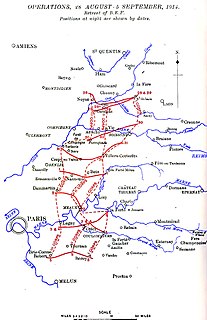 W
WThe Great Retreat, also known as the Retreat from Mons, is the name given to the long withdrawal to the River Marne in August and September 1914 by the British Expeditionary Force (BEF) and the French Fifth Army, Allied forces on the Western Front in the First World War, after their defeat by the armies of the German Empire at the Battle of Charleroi and the Battle of Mons. A counteroffensive by the Fifth Army, with some assistance from the BEF, at the First Battle of Guise failed to end the German advance, and the retreat continued to and beyond the Marne. From 5 to 12 September, the First Battle of the Marne ended the Allied retreat and forced the German armies to retire towards the Aisne River and to fight the First Battle of the Aisne (13–28 September). Reciprocal attempts to outflank the opposing armies to the north known as the Race to the Sea followed (17 September – 17 October).
 W
WThe Second Boer War was fought between the British Empire and two independent Boer states, the South African Republic and the Orange Free State, over the Empire's influence in South Africa. The trigger of the war was the discovery of diamonds and gold in the Boer states. The war is also known as the Boer War, Anglo-Boer War, or South African War. Initial Boer attacks were successful, and although British reinforcements later reversed these, the war continued for years with Boer guerrilla warfare, until harsh British counter-measures including a scorched earth policy brought the Boers to terms.
 W
WThe First Battle of the Aisne was the Allied follow-up offensive against the right wing of the German First Army and the Second Army as they retreated after the First Battle of the Marne earlier in September 1914. The Advance to the Aisne consisted of the Battle of the Marne (7–10 September) and the Battle of the Aisne (12–15 September).
 W
WThe Third Battle of the Aisne was a battle of the German Spring Offensive during World War I that focused on capturing the Chemin des Dames Ridge before the American Expeditionary Forces arrived completely in France. It was one of a series of offensives, known as the Kaiserschlacht, launched by the Germans in the spring and summer of 1918.
 W
WThe Battle of the Ancre Heights, is the name given to the continuation of British attacks after the Battle of Thiepval Ridge from 26 to 28 September during the Battle of the Somme. The battle was conducted by the Reserve Army from Courcelette near the Albert–Bapaume road, west to Thiepval on Bazentin Ridge. British possession of the heights would deprive the German 1st Army of observation towards Albert to the south-west and give the British observation north over the Ancre valley to the German positions around Beaumont-Hamel, Serre and Beaucourt. The Reserve Army conducted large attacks on 1, 8, 21, 25 October and from 10 to 11 November.
 W
WThe Second Battle of the Sambre (which included the Second Battle of Guise and the Battle of Thiérache was part of the final European Allied offensives of World War I.
 W
WThe Battle of Villers-Bocage took place during the Second World War on 13 June 1944, one week after the Normandy Landings, which had begun the Western Allies' conquest of German-occupied France. The battle was the result of a British attempt to improve their position by exploiting a gap in the German defences west of the city of Caen. After one day of fighting in and around the small town of Villers-Bocage and a second day defending a position outside the town, the British force retreated.
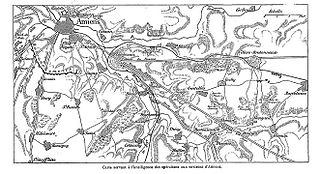 W
WThe First Battle of Villers-Bretonneux, took place during Operation Michael, part of the German Spring Offensive on the Western Front. The offensive began against the British Fifth Army and the Third Army on the Somme and pushed back the British and French reinforcements on the north side of the Somme. The capture of Villers-Bretonneux, close to Amiens, a strategically important road- and rail-junction, would have brought the Germans within artillery-range. In late March, Australian troops were brought south from Belgium as reinforcements to help shore up the line and in early April the Germans launched an attack to capture Villers-Bretonneux. After a determined defence by British and Australian troops, the attackers were close to success until a counter-attack by the 9th Australian Infantry Brigade and British troops late in the afternoon of 4 April restored the situation and halted the German advance on Amiens.
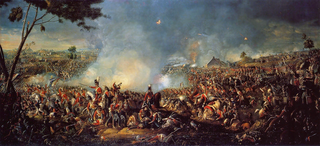 W
WThe Battle of Waterloo was fought on Sunday, 18 June 1815, near Waterloo in Belgium, part of the United Kingdom of the Netherlands at the time. A French army under the command of Emperor Napoleon Bonaparte was defeated by two of the armies of the Seventh Coalition, a British-led coalition consisting of units from the United Kingdom, the Netherlands, Hanover, Brunswick and Nassau, under the command of the Duke of Wellington, referred to by many authors as the Anglo-allied army or Wellington's army, and a Prussian army under the command of Field Marshal von Blücher, referred also as Blücher's army. The battle marked the end of the Napoleonic Wars.
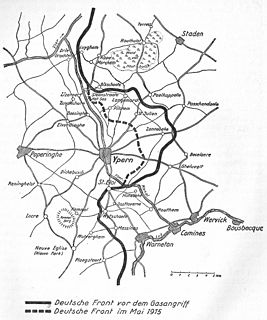 W
WDuring World War I, the Second Battle of Ypres was fought from 22 April – 25 May 1915 for control of the strategic Flemish town of Ypres in western Belgium. The First Battle of Ypres had been fought the previous autumn. The Second Battle of Ypres was the first mass use by Germany of poison gas on the Western Front. It also marked the first time a former colonial force defeated a European power in Europe.